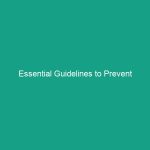Introduction
Good morning team,
Today, we are going to discuss an important topic that affects each one of us in our daily work Environment: Essential Office Safety Guidelines: Avoid Common Risks Today!. Understanding and adhering to these guidelines is crucial for maintaining a safe and productive workplace.
Office Safety is not just a regulatory requirement; it is about ensuring that everyone goes home safe at the end of the day. From slips and falls to ergonomic Hazards, being aware of these risks can help us mitigate them effectively. So let’s dive into the essential guidelines that can help us create a safer office environment.
Understanding Essential Office Safety Guidelines
Essential office Safety guidelines encompass practices and protocols designed to minimize risks that can lead to injuries or accidents in the workplace. These guidelines are fundamental in safeguarding our health and well-being while enhancing productivity.
Ignoring safety protocols can lead to serious consequences, not just for individuals but for the entire organization. Misconceptions often arise around safety practices; some employees may believe that accidents are rare or that they can happen to someone else. However, statistics show that office-related injuries are common and can be easily prevented.
Key Hazards, Risks, and Safety Considerations
Understanding the key hazards and risks associated with office environments is essential in creating a safe workplace. Here are some common hazards:
- Slips, Trips, and Falls: These can occur due to wet floors, cluttered walkways, or uneven surfaces.
- Ergonomic Risks: Poor workstation setup can lead to musculoskeletal disorders, including back and neck pain.
- Electrical Hazards: Overloaded outlets and frayed cords can pose serious risks of electrical shock or fire.
- Fire Safety: Lack of knowledge about fire exits and emergency Procedures can lead to dangerous situations during an emergency.
Ignoring these hazards can lead to injuries that may not only affect the individual but can also disrupt the entire team’s workflow and morale.
Best Practices, Procedures, & Actionable Advice
Now that we have identified potential hazards, let’s discuss Best Practices to minimize these risks:
1. Maintain a Clean and Organized Workspace
Ensure that walkways are clear of any obstructions. Regularly clean spills and ensure that personal items are stored properly. A tidy workspace contributes to overall safety.
2. Ergonomic Workstation Setup
Adjust your chair and desk to promote good posture and reduce strain. Here are some tips:
- Keep your feet flat on the ground or on a footrest.
- Adjust the height of your chair so that your knees are at 90 degrees.
- Position your screen at eye level to avoid neck strain.
3. Electrical Safety
Always inspect cords and outlets for any damages before use. Never overload electrical outlets and always follow the manufacturer’s instructions when using electrical equipment.
4. Fire Safety Training
Participate in fire drills and familiarize yourself with your office’s emergency exit routes. Ensure that fire extinguishers are accessible and that everyone knows how to use them.
5. Regular Breaks and Stretching
Encourage taking regular breaks to reduce fatigue and eye strain. Simple stretching exercises can help alleviate tension in your muscles.
Regulations, Standards, and Compliance
It is important to be aware of Regulations and Standards that govern Workplace Safety. The Occupational Safety and Health Administration (OSHA) provides guidelines that workplaces must adhere to in order to ensure employee safety. Compliance with these regulations is not just about avoiding fines; it is crucial for protecting our health and safety.
Additionally, your organization may have specific safety policies that align with these regulations. Familiarize yourself with them and understand your rights and responsibilities as an employee.
Employee Engagement & Discussion
Now, let’s open the floor for discussion. I encourage you all to think about the safety challenges you have encountered in the office. Here are a few questions to consider:
- What safety concerns have you noticed in your work area?
- Have you experienced any near-miss incidents? What can we learn from them?
- What additional Safety Measures do you think we should implement?
Your feedback is invaluable in helping us improve our Workplace Safety culture.
Conclusion & Key Takeaways
In conclusion, understanding and applying essential office safety guidelines is critical for everyone’s well-being. By maintaining a clean workspace, ensuring ergonomic setups, practicing electrical safety, participating in fire drills, and engaging in regular breaks, we can significantly reduce workplace risks.
Remember, safety is a shared responsibility. Let’s all commit to prioritizing these practices to create a safer working environment for ourselves and our colleagues.
Thank you for your attention and your commitment to making our workplace a safer place!


